High Frontiers
Human settlement of space has been a given since the earliest science fiction stories were written. However early stories typically envisaged settlement of existing worlds - construction on the planets and asteroids of this or other solar system. With the era of space exploration came the recognition that humanity might take one further step - the construction of our own artificial worlds and settlements in space.
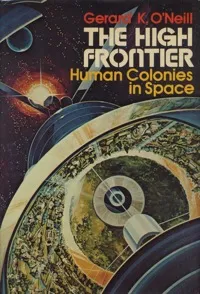 The High Frontier was an influential popular science book published in 1976 by an American physicist Gerard K. O’Neill. In it, he laid out the dangers that faced humanity on Earth in terms of energy supply, food, living space and population growth. In response, he summarised and expanded upon his more technical publications on the possible construction of space habitats, laying out a clear roadmap for what he saw as the effective and technically possible colonisation of space. In particular, O’Neill built on the already-widespread idea of using centrifugal force to replicate the effect of gravity.
The High Frontier was an influential popular science book published in 1976 by an American physicist Gerard K. O’Neill. In it, he laid out the dangers that faced humanity on Earth in terms of energy supply, food, living space and population growth. In response, he summarised and expanded upon his more technical publications on the possible construction of space habitats, laying out a clear roadmap for what he saw as the effective and technically possible colonisation of space. In particular, O’Neill built on the already-widespread idea of using centrifugal force to replicate the effect of gravity.
He proposed a sequential development of ever-larger space “islands” culminating with Island Threes in large, enclosed and pressurised cylinders that could be rotated around their long axis, providing a vast living space on their interior surfaces. Indeed, in the largest islands (Islands Four and Five), two linked cylinders would rotate in opposite directions, in order to balance any gyroscopic effects which could affect their stability. Their interiors would be divided into alternating strips of land and windows which, together with carefully placed and steerable mirrors, would control light and heat from the Sun. After initial constructions in Earth orbit (as a transit point) and on the Moon (permitting mining of resources), the space colonies would ultimately be located at an Earth-Moon Lagrange point - a point of gravitational balance at which minimal energy is required for position keeping or maintaining the orbit. Of these the optimal positions were identified as L4 and L5 - the Lagrange points on Earth-centred orbits similar to the Moon’s, and L5 became a verbal shorthand for the location of space colonies.
The High Frontier had an enormous impact, and cylindrical space habitats have since acquired the name O’Neill Cylinders.
It is perhaps worth noting that one of the best known, largest and most well realised such cylinders in science fiction actually predates O’Neill’s publications, and demonstrates that the concept was current in the space special-interest community. Arthur C. Clarke’s novel Rendezvous with Rama was published in 1973, and it too describes the interior surface of a very large cylinder which produces artificial gravity by rotation around a central axis [1]. In this case, the artefact is of alien design and ambiguous purpose, travelling through interstellar space rather than remaining in a fixed orbit. It is observed waking from hibernation as automatic systems begin to receive power from the Sun, but this only a brief sojourner in the Solar System. In many ways Rama is remarkably similar to O’Neill’s design, save that its shell appears to be thicker and that instead of windows it uses large valley-like arrays of artificial lights to warm and illuminate the interior.
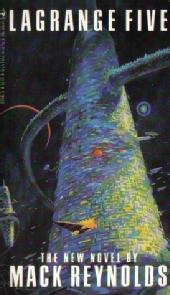 While Rama is perhaps the most ambiguous cylinder habitat in science fiction, it is also a very different prospect to the carefully laid-out geometric development of extant human technologies that O’Neill suggested could be plausible. Amongst the first to explore O’Neill’s full proposed programme in fiction was Mack Reynolds. His novel Lagrange 5 was published in 1979. followed by a prequel The Lagrangists (1983) and a sequel Chaos in Lagrangia (1984). The first book is dedicated to O’Neill and acknowledges discussion with the physicist and his team. Indeed, one of the key characters in the novel is Professor George R. Casey, described as the “father of the Lagrange project” and clearly modelled on Gerard K. O’Neill himself. This series of novels is wide-eyed regarding the attraction of space colonisation and the feasibility of the project, but it does not shy away from some of the problems likely to arise - in particular due to the social and political upheavals that would accompany it.
While Rama is perhaps the most ambiguous cylinder habitat in science fiction, it is also a very different prospect to the carefully laid-out geometric development of extant human technologies that O’Neill suggested could be plausible. Amongst the first to explore O’Neill’s full proposed programme in fiction was Mack Reynolds. His novel Lagrange 5 was published in 1979. followed by a prequel The Lagrangists (1983) and a sequel Chaos in Lagrangia (1984). The first book is dedicated to O’Neill and acknowledges discussion with the physicist and his team. Indeed, one of the key characters in the novel is Professor George R. Casey, described as the “father of the Lagrange project” and clearly modelled on Gerard K. O’Neill himself. This series of novels is wide-eyed regarding the attraction of space colonisation and the feasibility of the project, but it does not shy away from some of the problems likely to arise - in particular due to the social and political upheavals that would accompany it.
Reynolds’ Lagrange project progresses to the construction of a huge pair of O’Neill cylinders, and effectively solves the problem of Earth-side power shortages through deployment of space-borne solar power stations. However it is opposed by representatives of a Soviet eastern bloc, the mafia, oil-producing countries and religious extremists. It is also prey to internal dilemmas - in particular over racial injustice, socio-economic concerns and eugenicist themes. Clear tensions develop between generations and between those who want to seed the stars with the “best” of humanity as opposed to believing it should be open to all.
Inevitably, four decades later, Reynolds’ well-meant attempts to articulate the controversial themes of his own time - particularly civil rights - come across as rather uncomfortable and tone-deaf in terms of language usage. Reynolds also has a somewhat idealistic and stereotyped perception of scientists, and leans heavily towards the use of Intelligence Quotient (IQ) as a tool - one which is unfortunately now known to be heavily subject to cultural bias and very sensitive to privilege rather than intrinsic ability. However his novels nonetheless ask some valid questions: given the huge cost of establishing space colonies, who will provide the initial investment, how will their occupants be selected, and by what criteria? They also ask a serious question regarding what will drive space settlement - if poor conditions can be remedied on Earth (for example using goods, food and power manufactured on automated space stations) will there actually be motivation for Solar System space colonisation at all?
Reynolds was not the only creator inspired by O’Neill’s work. Another science fiction narrative that closely follows the High Frontier model can be found in Tom Swift: The City in the Stars (Appleton, 1981, written pseudonymously by William Rotsler & Sharmon Divono). This novel launched the third series of books about teenage inventor and genius Tom Swift, aimed at juvenile readers. Its O'Neill cylinder, New America, hosts a population of fifty-thousand at L5, and its long windows, external mirrors, internal land use and external factories and solar power generators are all remarkably similar to those described by O'Neill and by Mack Reynolds, to the extent that the cycle-powered aircraft (which allow movement along the gravity-free cylinder axis) that are an important plot device in Reynolds' Lagrange 5 also appear here, although now set against the backdrop of a spaceship race rather than political upheavals. The widespread impact of O'Neill's ideas can also be seen in perhaps unexpected places. Thunderbirds 2086 was a Japanese animated series aimed at children and loosely based on the Century 21 television series Thunderbirds [2]. Originally broadcast in Japanese in 1982, the English-language dub was broadcast in the UK in 1986. Its first episode, “Firefall”, introduces the International Rescue Organisation team and equipment by involving them in the rescue of the captain of a crippled space colony, Rosinante. Presumably named for Don Quixote’s horse, Rocinante, the station is a well-realised visualisation of an O’Neill cylinder which closely follows his original specifications. The available technical information is limited, but the cylinder’s profile and mirrors are very familiar, and the colony is described as threatening its neighbours at L5 when its power source threatens to explode.
The widespread impact of O'Neill's ideas can also be seen in perhaps unexpected places. Thunderbirds 2086 was a Japanese animated series aimed at children and loosely based on the Century 21 television series Thunderbirds [2]. Originally broadcast in Japanese in 1982, the English-language dub was broadcast in the UK in 1986. Its first episode, “Firefall”, introduces the International Rescue Organisation team and equipment by involving them in the rescue of the captain of a crippled space colony, Rosinante. Presumably named for Don Quixote’s horse, Rocinante, the station is a well-realised visualisation of an O’Neill cylinder which closely follows his original specifications. The available technical information is limited, but the cylinder’s profile and mirrors are very familiar, and the colony is described as threatening its neighbours at L5 when its power source threatens to explode.
By the 1990s, the cylindrical space habitat was very much part of the visual lexicon of science fiction.
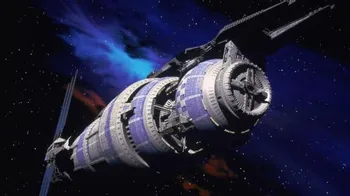
Amongst the most prominent examples was Babylon 5, the central setting of the eponymous television series (1993-1998). Rather than being located within the Earth-Moon system, Babylon 5 was sited in the Epsilon Eridani star system, at a star-planet L5 point, and adjacent to a “jump point” (which allowed interstellar travel). It also combined the functions of a military base, commercial centre and diplomatic enclave, rather than being primarily a civilian colony. Like all O’Neill cylinders, however, the station generated artificial gravity through rotation, although the necessity of this is perhaps unclear since various ships and environments in the series also demonstrate the existence of non-centrifugal artificial gravity. The centrifuge cylinder is about five miles long, and is canonically home to “a quarter of a million humans and aliens” and largely self-sufficient.
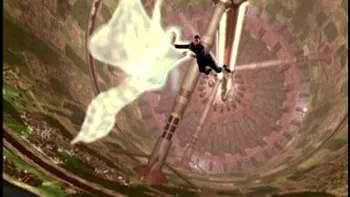 Visualisations of the cylinder interior are rare (likely due to special effects budget constraints), with most of the action confined to enclosed regions such as the slum area close to the station outer hull known as DownBelow, or the ambassadorial or command quarters. However the physical properties of the cylinder habitat are very effectively used in the episode “The Fall of Night” (1995). Here, the station commander Captain Sheridan is forced to jump from a monorail which runs along the gravity-free central axis of the station, above the hydroponics section which occupies some of the central cavity. As his deputy, Susan Ivanova notes: “He’s more or less weightless but the ground is rotating at 60 miles an hour. If we can’t catch him, he’ll be killed by the impact”. Given no more than thirty seconds to reach Sheridan with a jet pack, this presents a near-insurmountable challenge in the story. In fact, the speed suggested by Ivanova is actually rather low, and suggests that Sheridan is falling to a surface perhaps only 100 metres below the monorail - not entirely consistent with the visual appearance of the scene. Given a more realistic estimate of the cylinder’s inner diameter of perhaps half a mile, the ground would actually be moving at more like 140 miles per hour!
Visualisations of the cylinder interior are rare (likely due to special effects budget constraints), with most of the action confined to enclosed regions such as the slum area close to the station outer hull known as DownBelow, or the ambassadorial or command quarters. However the physical properties of the cylinder habitat are very effectively used in the episode “The Fall of Night” (1995). Here, the station commander Captain Sheridan is forced to jump from a monorail which runs along the gravity-free central axis of the station, above the hydroponics section which occupies some of the central cavity. As his deputy, Susan Ivanova notes: “He’s more or less weightless but the ground is rotating at 60 miles an hour. If we can’t catch him, he’ll be killed by the impact”. Given no more than thirty seconds to reach Sheridan with a jet pack, this presents a near-insurmountable challenge in the story. In fact, the speed suggested by Ivanova is actually rather low, and suggests that Sheridan is falling to a surface perhaps only 100 metres below the monorail - not entirely consistent with the visual appearance of the scene. Given a more realistic estimate of the cylinder’s inner diameter of perhaps half a mile, the ground would actually be moving at more like 140 miles per hour!
In the context of the series, the Babylon 5 station was the final product of an ill-fated project, in which the first three Babylon stations were destroyed by sabotage, and the fourth completed but vanished, before Babylon 5 was constructed and came online in 2258. It’s interesting to note that the lost Babylon 4 was actually larger than its later sibling, consisting of a double cylinder, the two halves of which counter-rotated as O’Neill had proposed in High Frontier, and as Mack Reynolds imagined in his Lagrange 5, as opposed to Babylon 5’s single centrifuged section.
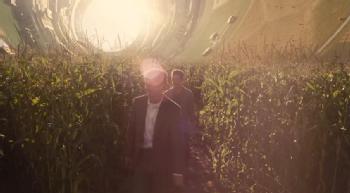
More recently still, the alien perspectives offered by a cylindrical habitat have been used to effectively capture the artificial and mind-bending environments of space, and to demonstrate its practical colonisation in film and television. The final sequences of the 2014 blockbuster film Interstellar (dir:Nolan) take place aboard Cooper Station - an O’Neill cylinder in orbit of Saturn, which has been enabled by physicist Murphy Cooper’s insights into the nature of gravity. The cylinder’s use is clearly both domestic and agricultural, and while its mechanisms are not discussed in detail, we’re introduced to centrifugal artificial gravity by following the flight path of a baseball driven through the axis to shatter a window in a settlement which hangs overhead.
A similar dramatic visual impact was made in the recent television series The Expanse (2015-present, based on novels from James S. A. Corey). In this series, the Nauvoo is a generation ship intended to take colonists from a religious minority on a century-long journey to the Tau Ceti star system, but is later repurposed as a battleship (challenging given its rotating drum and limited manoeuvrability) and then as a space station. This vessel is more compact than most O’Neill cylinders seen in fiction, largely since it was originally designed as an interstellar vessel rather than static, but nonetheless satisfies the essential criteria of boasting an agricultural and domestic living space on its interior surface, with artificial gravity provided by centrifugal force. As was the case in Interstellar, the warped topology of a centrifuge, with plants and buildings apparently hanging overhead from any point on the interior surface, was used for as a visual short hand for the alien nature of the environment when compared to a planetary surface. Unfortunately for the Nauvoo, the ship’s military career and conflict environment prevented it achieving the pleasant green habitability of Interstellar’s Cooper station.
These are just a few examples of the many cylindrical habitats to be found in science fiction [3]. They have never lost their appeal - indeed billionaire Jeff Bezos has recently advocated a return to the cylinder settlement concept. So why is this concept so attractive to scientists, writers and audiences? An O’Neill cylinder has a number of potential advantages over other forms of space habitat:
- While each is a self-contained environment, canonical cylinders enclose a sufficient volume to sustain a viable ecosystem and climate, reducing the dependence on chemical processing and mechanical tools relative to smaller vessels.
- The centrifugal forces on a long cylinder permits a large habitable area to be held at constant gravity - which would not be the case for, say, a rotating asteroid or for smaller craft in space. This allows a large population to be supported for an extended time period without bone loss or invoking unphysical artificial gravitation. Long sightlines across and along the cylinder would reduce the sense of confinement and isolation that might be expected in more conventional space stations or vessels. At the same time, sloped or hilly landscapes towards the ends of the cylinder or structures in the cylinder cap could permit lower gravity environments for manufacturing, health benefits or other purposes as desired.
- The topological reversal of the inside of the cylinder (i.e. a horizon that rises ahead and behind, rather than falls away) is at the same time comprehensible to an audience and entirely counter-intuitive, never arising on Earth. It permits us to process space in a familiar two dimensions (as on a planetary surface), rather than the three non-differentiated dimensions which can disorient astronauts and viewers in films such as Gravity. Thus it is an accessible visual short hand for an alien, space-borne environment, without being too jarring for most audiences. However it is not without its problems. For a long time, Clarke’s Rendezvous with Rama was considered unfilmable (a feature film is now under development) due to the difficulty of visualising its interior and the risk of nauseating its audience with its unfamiliar views. This is faced in the texts too: some of Reynolds’ Lagranists in his novel Lagrange Five suffer from a screaming claustrophobia brought on by the alien environment, which requires the colonists’ return to Earth.
- However the cylinder’s closed environment also offers a tempting half-way house to space - it’s clearly a non-terrestrial environment, but its occupants are effectively turning their back on the infinity of space, and the sense of agoraphobia and smallness it could inspire. The cocoon-like space is enclosed and potentially offers a feeling of security and comfort.
An O’Neill cylinder, then, offers a complex mix of visual and psychological cues both for potential settlers in the fictional context and for audiences viewing their adventures. Unfortunately, despite these advantages, space habitats on this scale are likely beyond the capacity of small groups or commercial agencies to construct. While O'Neill originally envisaged his islands in space as commercially motivated, and funded by investment which would otherwise go into the energy industries, the initial capital required and the risks involved are beyond what can reasonably be expected from commercial investors. The examples in science fiction are, almost without exception, constructed under the aegis of governmental or supergovernmental organisations. This has, perhaps, led to a reduction in the impact of The High Frontier paradigm in the modern era of commercialised and private space travel, and declining investment from public bodies. Should both the motivation and the financial backing for space colonisation ever be forthcoming, however, the O’Neill cylinder remains one of the best thought-through and plausible options for space settlement.
"High Frontiers", Elizabeth Stanway. Cosmic Stories blog. 24th July 2022
Notes:
[1] More limited usage of centrifuge rings in space stations or vessels had existed well before this, a notable example being the Clarke and Kubrick collaboration 2001: A Space Odyssey (film and novel, 1968), in which astronauts are seen jogging around an interior which could be a slice of an O’Neill cylinder. [Return to text]
[2] The Japanese original anime was named “Science Rescue Team TechnoBoyager”, in reference to the earlier Science Ninja Team Gatchaman (anime, 1972) and in order to provide the vehicles with the necessary TB acronym, and was licensed by ITC Entertainment (who owned the rights to Thunderbirds). The series did not involve Gerry or Sylvia Anderson who created the original 1960s series. [Return to text]
[3] Other cylindrical examples which skirt the borders of this definition include the great ship in Marrow (novel, Robert Reed, 2000) and the alien probe in Star Trek IV: The Voyage Home (film, 1986, dir: Nimoy), both of which are large enough to be considered megastructures, are apparently made of stone, and are of alien origin. Neither appears to create gravity through centrifugal force so are probably not technically O’Neill cylinders. [Return to text]
Note: All ideas and opinions expressed here are my own and do not necessarily reflect the views of the University of Warwick. Images have been sourced from publicly-accessible websites online and are used here for commentary and criticism.
